Shuang Zeng
UniMapGen: A Generative Framework for Large-Scale Map Construction from Multi-modal Data
Sep 26, 2025Abstract:Large-scale map construction is foundational for critical applications such as autonomous driving and navigation systems. Traditional large-scale map construction approaches mainly rely on costly and inefficient special data collection vehicles and labor-intensive annotation processes. While existing satellite-based methods have demonstrated promising potential in enhancing the efficiency and coverage of map construction, they exhibit two major limitations: (1) inherent drawbacks of satellite data (e.g., occlusions, outdatedness) and (2) inefficient vectorization from perception-based methods, resulting in discontinuous and rough roads that require extensive post-processing. This paper presents a novel generative framework, UniMapGen, for large-scale map construction, offering three key innovations: (1) representing lane lines as \textbf{discrete sequence} and establishing an iterative strategy to generate more complete and smooth map vectors than traditional perception-based methods. (2) proposing a flexible architecture that supports \textbf{multi-modal} inputs, enabling dynamic selection among BEV, PV, and text prompt, to overcome the drawbacks of satellite data. (3) developing a \textbf{state update} strategy for global continuity and consistency of the constructed large-scale map. UniMapGen achieves state-of-the-art performance on the OpenSatMap dataset. Furthermore, UniMapGen can infer occluded roads and predict roads missing from dataset annotations. Our code will be released.
JanusVLN: Decoupling Semantics and Spatiality with Dual Implicit Memory for Vision-Language Navigation
Sep 26, 2025Abstract:Vision-and-Language Navigation requires an embodied agent to navigate through unseen environments, guided by natural language instructions and a continuous video stream. Recent advances in VLN have been driven by the powerful semantic understanding of Multimodal Large Language Models. However, these methods typically rely on explicit semantic memory, such as building textual cognitive maps or storing historical visual frames. This type of method suffers from spatial information loss, computational redundancy, and memory bloat, which impede efficient navigation. Inspired by the implicit scene representation in human navigation, analogous to the left brain's semantic understanding and the right brain's spatial cognition, we propose JanusVLN, a novel VLN framework featuring a dual implicit neural memory that models spatial-geometric and visual-semantic memory as separate, compact, and fixed-size neural representations. This framework first extends the MLLM to incorporate 3D prior knowledge from the spatial-geometric encoder, thereby enhancing the spatial reasoning capabilities of models based solely on RGB input. Then, the historical key-value caches from the spatial-geometric and visual-semantic encoders are constructed into a dual implicit memory. By retaining only the KVs of tokens in the initial and sliding window, redundant computation is avoided, enabling efficient incremental updates. Extensive experiments demonstrate that JanusVLN outperforms over 20 recent methods to achieve SOTA performance. For example, the success rate improves by 10.5-35.5 compared to methods using multiple data types as input and by 3.6-10.8 compared to methods using more RGB training data. This indicates that the proposed dual implicit neural memory, as a novel paradigm, explores promising new directions for future VLN research. Ours project page: https://miv-xjtu.github.io/JanusVLN.github.io/.
FutureSightDrive: Thinking Visually with Spatio-Temporal CoT for Autonomous Driving
May 23, 2025Abstract:Visual language models (VLMs) have attracted increasing interest in autonomous driving due to their powerful reasoning capabilities. However, existing VLMs typically utilize discrete text Chain-of-Thought (CoT) tailored to the current scenario, which essentially represents highly abstract and symbolic compression of visual information, potentially leading to spatio-temporal relationship ambiguity and fine-grained information loss. Is autonomous driving better modeled on real-world simulation and imagination than on pure symbolic logic? In this paper, we propose a spatio-temporal CoT reasoning method that enables models to think visually. First, VLM serves as a world model to generate unified image frame for predicting future world states: where perception results (e.g., lane divider and 3D detection) represent the future spatial relationships, and ordinary future frame represent the temporal evolution relationships. This spatio-temporal CoT then serves as intermediate reasoning steps, enabling the VLM to function as an inverse dynamics model for trajectory planning based on current observations and future predictions. To implement visual generation in VLMs, we propose a unified pretraining paradigm integrating visual generation and understanding, along with a progressive visual CoT enhancing autoregressive image generation. Extensive experimental results demonstrate the effectiveness of the proposed method, advancing autonomous driving towards visual reasoning.
Novel Extraction of Discriminative Fine-Grained Feature to Improve Retinal Vessel Segmentation
May 06, 2025Abstract:Retinal vessel segmentation is a vital early detection method for several severe ocular diseases. Despite significant progress in retinal vessel segmentation with the advancement of Neural Networks, there are still challenges to overcome. Specifically, retinal vessel segmentation aims to predict the class label for every pixel within a fundus image, with a primary focus on intra-image discrimination, making it vital for models to extract more discriminative features. Nevertheless, existing methods primarily focus on minimizing the difference between the output from the decoder and the label, but ignore fully using feature-level fine-grained representations from the encoder. To address these issues, we propose a novel Attention U-shaped Kolmogorov-Arnold Network named AttUKAN along with a novel Label-guided Pixel-wise Contrastive Loss for retinal vessel segmentation. Specifically, we implement Attention Gates into Kolmogorov-Arnold Networks to enhance model sensitivity by suppressing irrelevant feature activations and model interpretability by non-linear modeling of KAN blocks. Additionally, we also design a novel Label-guided Pixel-wise Contrastive Loss to supervise our proposed AttUKAN to extract more discriminative features by distinguishing between foreground vessel-pixel pairs and background pairs. Experiments are conducted across four public datasets including DRIVE, STARE, CHASE_DB1, HRF and our private dataset. AttUKAN achieves F1 scores of 82.50%, 81.14%, 81.34%, 80.21% and 80.09%, along with MIoU scores of 70.24%, 68.64%, 68.59%, 67.21% and 66.94% in the above datasets, which are the highest compared to 11 networks for retinal vessel segmentation. Quantitative and qualitative results show that our AttUKAN achieves state-of-the-art performance and outperforms existing retinal vessel segmentation methods. Our code will be available at https://github.com/stevezs315/AttUKAN.
SuperCL: Superpixel Guided Contrastive Learning for Medical Image Segmentation Pre-training
Apr 20, 2025Abstract:Medical image segmentation is a critical yet challenging task, primarily due to the difficulty of obtaining extensive datasets of high-quality, expert-annotated images. Contrastive learning presents a potential but still problematic solution to this issue. Because most existing methods focus on extracting instance-level or pixel-to-pixel representation, which ignores the characteristics between intra-image similar pixel groups. Moreover, when considering contrastive pairs generation, most SOTA methods mainly rely on manually setting thresholds, which requires a large number of gradient experiments and lacks efficiency and generalization. To address these issues, we propose a novel contrastive learning approach named SuperCL for medical image segmentation pre-training. Specifically, our SuperCL exploits the structural prior and pixel correlation of images by introducing two novel contrastive pairs generation strategies: Intra-image Local Contrastive Pairs (ILCP) Generation and Inter-image Global Contrastive Pairs (IGCP) Generation. Considering superpixel cluster aligns well with the concept of contrastive pairs generation, we utilize the superpixel map to generate pseudo masks for both ILCP and IGCP to guide supervised contrastive learning. Moreover, we also propose two modules named Average SuperPixel Feature Map Generation (ASP) and Connected Components Label Generation (CCL) to better exploit the prior structural information for IGCP. Finally, experiments on 8 medical image datasets indicate our SuperCL outperforms existing 12 methods. i.e. Our SuperCL achieves a superior performance with more precise predictions from visualization figures and 3.15%, 5.44%, 7.89% DSC higher than the previous best results on MMWHS, CHAOS, Spleen with 10% annotations. Our code will be released after acceptance.
Exploiting Inherent Class Label: Towards Robust Scribble Supervised Semantic Segmentation
Mar 18, 2025Abstract:Scribble-based weakly supervised semantic segmentation leverages only a few annotated pixels as labels to train a segmentation model, presenting significant potential for reducing the human labor involved in the annotation process. This approach faces two primary challenges: first, the sparsity of scribble annotations can lead to inconsistent predictions due to limited supervision; second, the variability in scribble annotations, reflecting differing human annotator preferences, can prevent the model from consistently capturing the discriminative regions of objects, potentially leading to unstable predictions. To address these issues, we propose a holistic framework, the class-driven scribble promotion network, for robust scribble-supervised semantic segmentation. This framework not only utilizes the provided scribble annotations but also leverages their associated class labels to generate reliable pseudo-labels. Within the network, we introduce a localization rectification module to mitigate noisy labels and a distance perception module to identify reliable regions surrounding scribble annotations and pseudo-labels. In addition, we introduce new large-scale benchmarks, ScribbleCOCO and ScribbleCityscapes, accompanied by a scribble simulation algorithm that enables evaluation across varying scribble styles. Our method demonstrates competitive performance in both accuracy and robustness, underscoring its superiority over existing approaches. The datasets and the codes will be made publicly available.
Exploring the Vulnerabilities of Federated Learning: A Deep Dive into Gradient Inversion Attacks
Mar 13, 2025
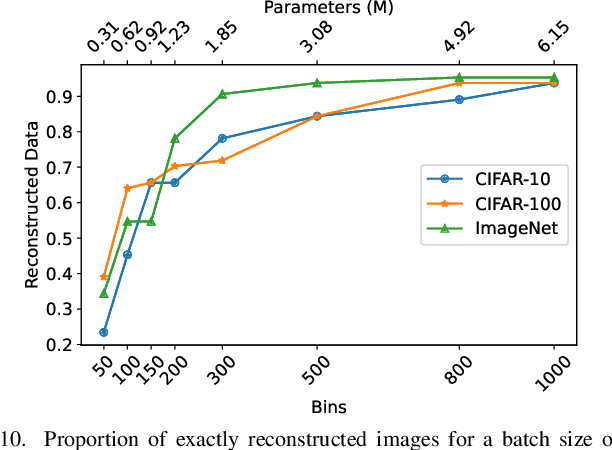
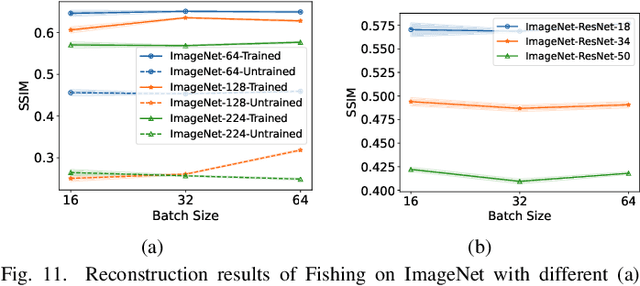
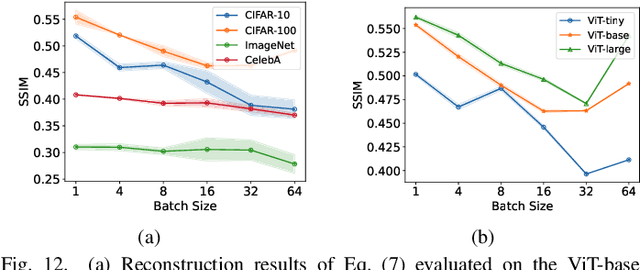
Abstract:Federated Learning (FL) has emerged as a promising privacy-preserving collaborative model training paradigm without sharing raw data. However, recent studies have revealed that private information can still be leaked through shared gradient information and attacked by Gradient Inversion Attacks (GIA). While many GIA methods have been proposed, a detailed analysis, evaluation, and summary of these methods are still lacking. Although various survey papers summarize existing privacy attacks in FL, few studies have conducted extensive experiments to unveil the effectiveness of GIA and their associated limiting factors in this context. To fill this gap, we first undertake a systematic review of GIA and categorize existing methods into three types, i.e., \textit{optimization-based} GIA (OP-GIA), \textit{generation-based} GIA (GEN-GIA), and \textit{analytics-based} GIA (ANA-GIA). Then, we comprehensively analyze and evaluate the three types of GIA in FL, providing insights into the factors that influence their performance, practicality, and potential threats. Our findings indicate that OP-GIA is the most practical attack setting despite its unsatisfactory performance, while GEN-GIA has many dependencies and ANA-GIA is easily detectable, making them both impractical. Finally, we offer a three-stage defense pipeline to users when designing FL frameworks and protocols for better privacy protection and share some future research directions from the perspectives of attackers and defenders that we believe should be pursued. We hope that our study can help researchers design more robust FL frameworks to defend against these attacks.
V2C-CBM: Building Concept Bottlenecks with Vision-to-Concept Tokenizer
Jan 09, 2025


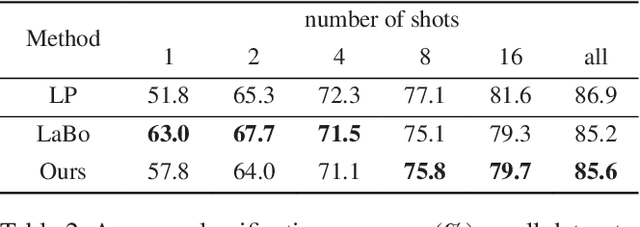
Abstract:Concept Bottleneck Models (CBMs) offer inherent interpretability by initially translating images into human-comprehensible concepts, followed by a linear combination of these concepts for classification. However, the annotation of concepts for visual recognition tasks requires extensive expert knowledge and labor, constraining the broad adoption of CBMs. Recent approaches have leveraged the knowledge of large language models to construct concept bottlenecks, with multimodal models like CLIP subsequently mapping image features into the concept feature space for classification. Despite this, the concepts produced by language models can be verbose and may introduce non-visual attributes, which hurts accuracy and interpretability. In this study, we investigate to avoid these issues by constructing CBMs directly from multimodal models. To this end, we adopt common words as base concept vocabulary and leverage auxiliary unlabeled images to construct a Vision-to-Concept (V2C) tokenizer that can explicitly quantize images into their most relevant visual concepts, thus creating a vision-oriented concept bottleneck tightly coupled with the multimodal model. This leads to our V2C-CBM which is training efficient and interpretable with high accuracy. Our V2C-CBM has matched or outperformed LLM-supervised CBMs on various visual classification benchmarks, validating the efficacy of our approach.
A New Federated Learning Framework Against Gradient Inversion Attacks
Dec 10, 2024Abstract:Federated Learning (FL) aims to protect data privacy by enabling clients to collectively train machine learning models without sharing their raw data. However, recent studies demonstrate that information exchanged during FL is subject to Gradient Inversion Attacks (GIA) and, consequently, a variety of privacy-preserving methods have been integrated into FL to thwart such attacks, such as Secure Multi-party Computing (SMC), Homomorphic Encryption (HE), and Differential Privacy (DP). Despite their ability to protect data privacy, these approaches inherently involve substantial privacy-utility trade-offs. By revisiting the key to privacy exposure in FL under GIA, which lies in the frequent sharing of model gradients that contain private data, we take a new perspective by designing a novel privacy preserve FL framework that effectively ``breaks the direct connection'' between the shared parameters and the local private data to defend against GIA. Specifically, we propose a Hypernetwork Federated Learning (HyperFL) framework that utilizes hypernetworks to generate the parameters of the local model and only the hypernetwork parameters are uploaded to the server for aggregation. Theoretical analyses demonstrate the convergence rate of the proposed HyperFL, while extensive experimental results show the privacy-preserving capability and comparable performance of HyperFL. Code is available at https://github.com/Pengxin-Guo/HyperFL.
Selective Aggregation for Low-Rank Adaptation in Federated Learning
Oct 02, 2024
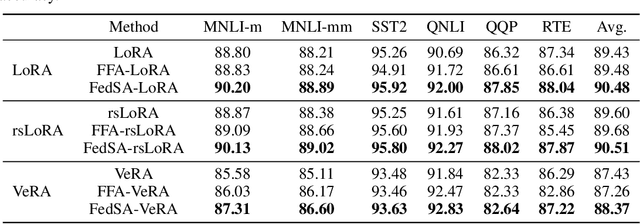
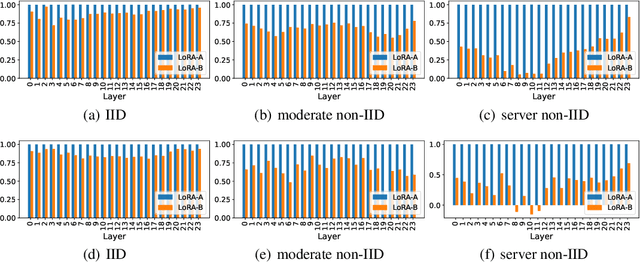

Abstract:We investigate LoRA in federated learning through the lens of the asymmetry analysis of the learned $A$ and $B$ matrices. In doing so, we uncover that $A$ matrices are responsible for learning general knowledge, while $B$ matrices focus on capturing client-specific knowledge. Based on this finding, we introduce Federated Share-A Low-Rank Adaptation (FedSA-LoRA), which employs two low-rank trainable matrices $A$ and $B$ to model the weight update, but only $A$ matrices are shared with the server for aggregation. Moreover, we delve into the relationship between the learned $A$ and $B$ matrices in other LoRA variants, such as rsLoRA and VeRA, revealing a consistent pattern. Consequently, we extend our FedSA-LoRA method to these LoRA variants, resulting in FedSA-rsLoRA and FedSA-VeRA. In this way, we establish a general paradigm for integrating LoRA with FL, offering guidance for future work on subsequent LoRA variants combined with FL. Extensive experimental results on natural language understanding and generation tasks demonstrate the effectiveness of the proposed method.
 Add to Chrome
Add to Chrome Add to Firefox
Add to Firefox Add to Edge
Add to Edge